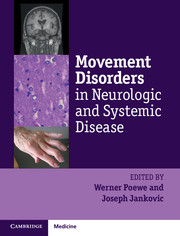Book contents
- Frontmatter
- Contents
- List of contributors
- List of videos
- List of abbreviations
- Preface
- Section I General principles
- Section II Movement disorders in systemic disease
- Chapter 4 Paraneoplastic movement disorders
- Chapter 5 Movement disorders of autoimmune origin
- Chapter 6 Movement disorders in systemic infections
- Chapter 7 Movement disorders in HIV- and AIDS-related central nervous system infections
- Chapter 8 Movement disorders in metabolic diseases in adulthood
- Chapter 9 Movement disorders in childhood metabolic diseases
- Chapter 10 Movement disorders in endocrinological diseases
- Chapter 11 Movement disorders in liver disease
- Chapter 12 Movement disorders in renal diseases
- Chapter 13 Movement disorders in hematological disease
- Section III Iatrogenic and toxic movement disorders
- Section IV Movement disorders in general neurology
- Section V Systemic complications of movement disorders
- Index
- Plate Section
- References
Chapter 7 - Movement disorders in HIV- and AIDS-related central nervous system infections
from Section II - Movement disorders in systemic disease
Published online by Cambridge University Press: 05 April 2014
- Frontmatter
- Contents
- List of contributors
- List of videos
- List of abbreviations
- Preface
- Section I General principles
- Section II Movement disorders in systemic disease
- Chapter 4 Paraneoplastic movement disorders
- Chapter 5 Movement disorders of autoimmune origin
- Chapter 6 Movement disorders in systemic infections
- Chapter 7 Movement disorders in HIV- and AIDS-related central nervous system infections
- Chapter 8 Movement disorders in metabolic diseases in adulthood
- Chapter 9 Movement disorders in childhood metabolic diseases
- Chapter 10 Movement disorders in endocrinological diseases
- Chapter 11 Movement disorders in liver disease
- Chapter 12 Movement disorders in renal diseases
- Chapter 13 Movement disorders in hematological disease
- Section III Iatrogenic and toxic movement disorders
- Section IV Movement disorders in general neurology
- Section V Systemic complications of movement disorders
- Index
- Plate Section
- References
Summary
Introduction
There are a number of important infectious etiologies that must be considered in patients presenting with movement disorders. Abnormal movements have been recognized as the presenting sign of HIV infection since the 1980s (Nath et al. 1987). While the incidence in the developed world of certain classic movement disorders due to infections, such as Sydenham’s disease, has waned with greater antimicrobial availability, physicians continue to see a wide spectrum of infectious etiologies due to patients travelling long distances, as well as increased use of immunomodulatory agents and iatrogenic immune suppression. The recognition of infectious agents in the differential diagnosis of movement disorders can be of great clinical significance when treatment for the infection is available, such as in Whipple’s disease, which has been reported in association with AIDS (Jankovic 1986); in other cases, such as prion disease, in which treatment is not available, identification of the infectious etiology is important for diagnosis, prognosis, and epidemiological control to prevent potential spread of the infection. Recognition of infectious agents as the etiology of movement disorders may also assist with localization of the lesion (see Figure 7.1). In the case of HIV infection, which is to some extent treatable as a chronic infection, neurologists must recognize abnormal movements that may be a manifestation of the infection with HIV itself, as well as those movements attributable to opportunistic infections, and those that occur as complications of combined antiretroviral therapy (cART) or symptomatic treatment. With HIV-infected patients achieving much greater length of survival, there will likely be more cases of neurodegenerative disorders such as idiopathic Parkinson’s disease (PD), and thus issues related to management of PD in patients with HIV infection will also become increasingly salient.
- Type
- Chapter
- Information
- Movement Disorders in Neurologic and Systemic Disease , pp. 89 - 98Publisher: Cambridge University PressPrint publication year: 2014



